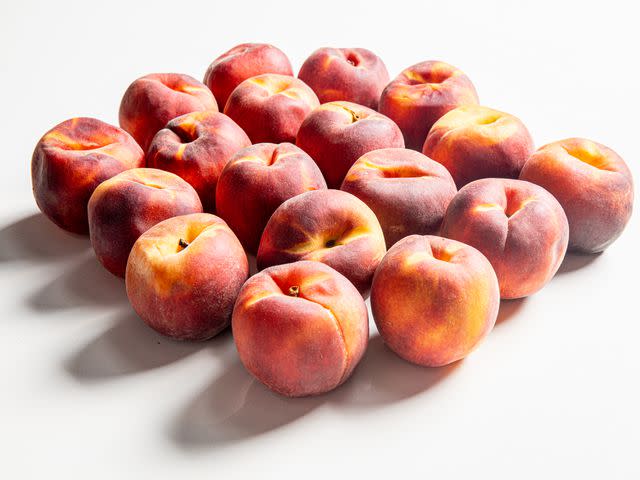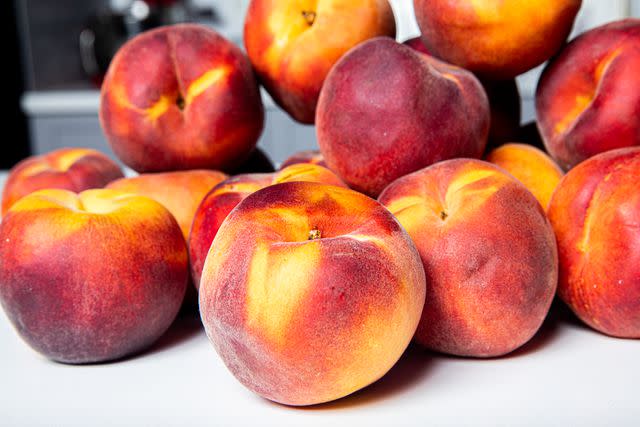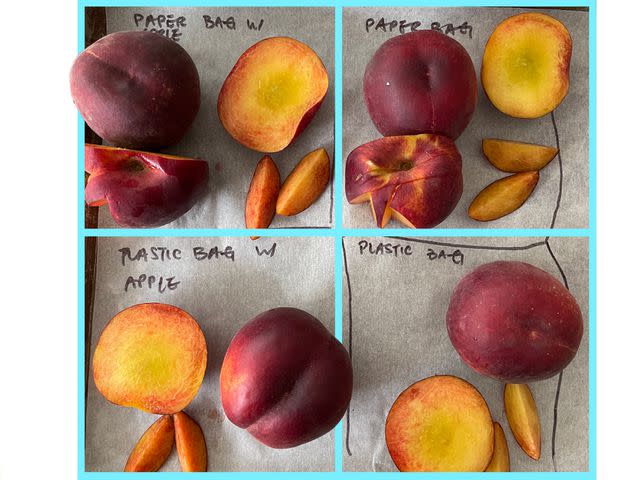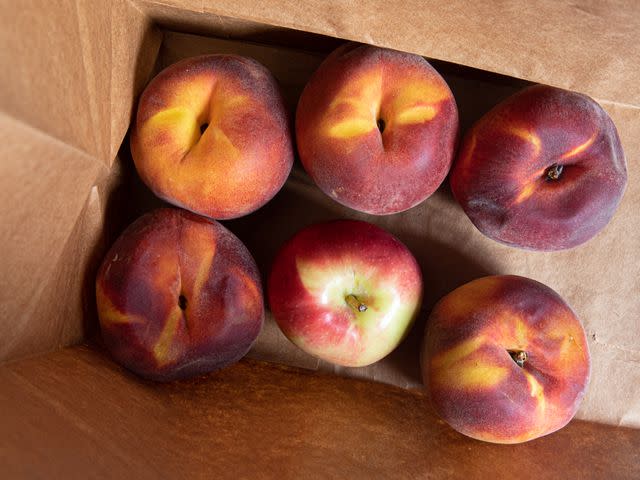The Foolproof Way to Ripen Peaches Every Time
Everything you need to know about selecting the best peaches and bringing them to ultimate ripeness at home.
TL;DR:
In our testing, we found that storing peaches in a paper bag with other ethylene-emitting fruit, like an apple or banana, was the most effective way to ripen them and produced the juiciest and most flavorful peaches.
Nothing beats the joy of biting into a sweet, juicy peach eaten at the height of summer—and there’s nothing worse than a mealy one that just won’t ripen no matter how long it’s been sitting on the counter. Over the years, I've heard various tips on how to best ripen peaches. Some recommend sealing the stone fruit in a paper bag with an apple or banana, some say to just leave them on your kitchen counter, and others suggest allowing your peaches to hang out in a warm spot until they’re tender enough to eat. But just how much riper can a peach become after being picked? To find out more about how peaches ripen, and the best ways to bring yours to a more perfect state at home, I read up on peach-ripening studies, ran my own ripening tests, and also talked to Mas Masumoto, an organic peach farmer in California and author of Epitaph for a Peach.

Serious Eats / Amanda Suarez
Do Peaches Ripen After Picking?
It's often disappointing to find that even when peaches are at their peak in July and August, most of the stone fruit available in grocery stores is rock-hard and unpleasant—if not impossible—to eat. This is because most of the fruit you see in supermarkets is picked unripe, as it has to survive the long journey from the farm to the store, leaving shoppers with subpar fruit that may or may not ever truly ripen.
Over Zoom, Masumoto pulled out a box of peaches to show me the difference between a peach picked too early and one plucked at the right time. Though both were still technically unripe, the difference between the two was obvious: The former was a pale green near the stem, while the latter was a warm amber. This, says Masumoto, is what farmers refer to as background color. If a peach has an underlying golden hue with a little give to it—an indication that it has developed enough internal ethylene, a gas and plant hormone—then it’s ready to come off the tree. These are the ones that will continue to mature on their journey to the market and after they’ve made it home with you.

Serious Eats / Amanda Suarez
Like bananas, tomatoes, plums, and pears (among many others), peaches are climacteric fruits, which means they’re able to continue ripening after they’ve been picked. Still, it’s essential that the fruit isn’t harvested too soon. According to Masumoto, a peach picked too green may not have enough internal ethylene to help it fully ripen off the plant. Instead of becoming sweet and tender, he says, the fruit will start to “dehydrate and become mealy.” Even when subjected to popular ripening methods, the fruit will never truly mature. It may eventually soften and turn yellow, but its flavor will never be as pronounced as a peach picked at the right time, its sweetness will never be as developed, and its texture will never be as juicy and silky.
Whether you’re able to ripen your peaches will ultimately depend on when they were plucked from the tree—a strong argument in favor of shopping at your local farmers market, farm stand, or other trusted produce vendor. Unlike fruit that has to be shipped across the country, fruit from a local farm can be picked as close to a few days before it’s sold, giving it more time to reach optimum ripeness.
Picking the Right Peach
Though it’s difficult to know if a peach is truly delicious until you take your first bite, there are some things you can look for when purchasing peaches that may hint at whether a peach is or eventually will be ready: its background color, texture, and aroma.
Background Color: To spot the background color of a peach, look near the stem end or "shoulder"—the upper curvature of the fruit around the stem end. You’ll see little reddish dots against the background, which is the blush. Ignore it. Look instead at the underlying background color beneath the dots. “A ripe yellow-flesh peach should have a yellow, amber, or golden hue behind the reddish blush,” Mas's daughter Nikiko Masumoto writes in their family’s book, The Perfect Peach. “The ripest peaches will appear to illuminate themselves from the inside out.” If you spot any green hue, it’s probably best to leave the peach behind.
Texture: According to Masumoto, a peach that is hard to the touch is unlikely to ever fully ripen and become flavorful, so those should be avoided. When shopping for peaches, it’s best to look for fruit that has a little give, which should absorb “subtle pressure and touch” without bruising when gently pressed; these peaches will come to full ripeness within a few days of purchase, depending on how you store them. He recommends using the pads of your fingers to squeeze ever so slightly, which will give you an idea of the peach’s texture while reducing the risk of bruising the fruit—and please do be careful, as it's not okay to ruin a vendor's fruit in one's quest for the perfect peach. A fully ripe peach that’s ready to eat, meanwhile, will be soft enough that it will bruise even when lightly squeezed. That's a peach you'd want to buy and eat soon after, possibly while still standing in the middle of a farmers market.
Aroma: Compare an unripe peach with a mature one, and you’ll notice that the former will have little to no aroma, while the ripe peach will have a sweet, floral smell. In On Food and Cooking, food scientist Harold McGee notes that as fruits ripen, their sugars increase as the starches and acid levels decrease, and a “characteristic aroma” develops. The delicate smell we associate with peaches comes from lactones, compounds that give peaches, nectarines, quince, and coconut their buttery, florid smell. So go ahead: pick up a peach and inhale deeply. If it smells sweet and fragrant, it’s a good sign that it’s already begun to ripen.
What's the Best Way to Fully Ripen Peaches?
To determine the most effective way to bring quality peaches to their perfect final ripeness level, I tested five methods. In each test, I let the fruit sit for three days at room temperature (74ºF/23ºC), then checked to see which ones fared the best flavor- and texture-wise.

Serious Eats / Genevieve Yam
Method 1: Paper Bag With an Apple or Banana
There’s a reason this method is popular: It’s because it works! Storing the peaches with other ethylene-emitting fruit, like an apple or a banana, helps to speed up the ripening process. “When triggered by ethylene,” writes McGee in On Food and Cooking, “the fruit stimulates itself by producing more ethylene, and begins to respire—to use up oxygen and produce carbon dioxide—from two to five times faster than before.”

Serious Eats / Amanda Suarez
After three days in a paper bag with an apple, the peaches were sweet with a balanced acidity, and very juicy. However, the skin was slightly wrinkled and the fruit was a little too soft; I suspect these peaches would have been perfect if they had been eaten a day earlier. This method produced the most flavorful peaches, though I recommend keeping a close eye on your fruit and checking daily to make sure they don’t soften too much.
Method 2: Paper Bag, No Accompanying Fruit
Though these peaches weren’t as flavorful as the fruit ripened alongside an apple, they were still sweet, very juicy, and had just the right amount of give after three days in a paper bag. If you don’t have an apple or banana at home, this method still produced peaches that were fairly ripe and still delicious to eat.
Method 3: Plastic Bag With an Apple or Banana
Curious to see if trapping as much ethylene as possible would be the best way to ripen peaches, I decided to seal some in a plastic bag with an apple. While these peaches did soften and had good give, they weren’t particularly juicy and had an unpleasant flavor and aroma that reminded me of nail polish remover. It’s likely that the plastic bag trapped too much ethylene, and that the paper bag worked much better because it was a more breathable material.
Method 4: Plastic Bag, No Accompanying Fruit
Like the peaches stored in a plastic bag with an apple, these peaches had great texture but terrible flavor. Do not—I repeat, do not—store your peaches in a plastic bag if you don’t want peaches that smell like nail polish remover!
Method 5: Kitchen Counter, No Bag
By day three, the peaches kept on the kitchen counter had a little give but were still fairly firm, and it took about five days for the fruit to feel and smell ripe. These peaches were juicy and tender, though not quite as delicious as the ones ripened in a paper bag with an apple. If you aren’t in a rush to eat your peaches and don’t feel particularly strongly about having the most flavorful peach, then storing them on your kitchen counter at room temperature works just fine.
This method can be combined with the paper bag (plus apple) method for a hybrid approach that delivers peaches over the course of a few days: Buy your peaches at the market, put some in a paper bag (ideally with an apple) to eat within a day or two, and leave the rest out on the counter to have ready a day or two after that.
What to Do With Your Peaches Once They're Ripened
If your peaches are ripe but you aren’t quite ready to eat or cook with them just yet, Masumoto recommends placing them in the refrigerator, which will slow the ripening process down and allow you to extend their shelf life by several days.
Curious to see if the position in which peaches are stored makes any difference, I tacked on one final test. My testing methodology for this round wasn’t sufficient to draw any solid conclusions, though my results indicated a very minor boost in moisture retention over the course of three days in peaches that were either stored stem side down or stem side up with tape over the stem dimple, compared to peaches that were stored stem side up with no covering. The effects were basically the same regardless of whether a physical piece of stem was still attached to the peach or not.
To be clear, I didn’t test the tape because I think taping up your peaches at home is practical or advisable—I don’t—but instead to check whether the literal upside down position is what matters, or merely any storage method that involves blocking moisture loss from the stem end (this mirrors a test Kenji did years ago on tomatoes). While I don’t think it makes a huge difference, it’s probably best to store peaches on their shoulders, stem side down, to prevent bruising and unnecessary moisture loss from the stem.
If you don’t have space in your fridge to store your ripe peaches, the worst case scenario also happens to be the best one: You might just have to eat them all at once, standing over your sink with the juices dripping down your chin. I'm not sure there's a better way.
Read the original article on Serious Eats.

